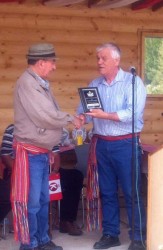Article Origin
Volume
Issue
Year
It was 1940, in the dog days of summer, less than a year after the Kikino Métis Settlement – then known as Good Fish Lake Colony Number Seven - was established on March 29, 1939, near Lac La Biche.
“I remember when we came over those hills on the old trail, and we saw the houses in the hamlet,” said Raymond Bellerose, then a 16 year-old boy traveling with his family. “There were just a few homes at that time, and they were all log cabins.”
There were 24 families living in Kikino when it was established. People cleared the land themselves, using the timber to build their houses and keeping their families warm on the long, dark winter nights. Logging was the only employment in the settlement and the founding families supplemented their income by hunting and trapping, and their diet with produce from their gardens.
Floyd Thompson, Kikino’s current Council chair, and a 44-year veteran of the Métis political scene, remembers the early days, too.
“I still remember vividly, every time somebody built a house, once they got four walls, there’d be an open air dance. And if there wasn’t a house being built next week, there would be a cake with a nickel in it, and whoever got the nickel had to host the next dance. I used to get chased home to bed because I was too little,” Thompson chuckled. “So I learned to sing because I knew I’d be welcome.”
Thompson started his political career on Kikino council in 1972 and served on the Métis General Council from 1994 to 2000. He worked on the Métis Settlement Accord in 1988, and sat on the Legislative Council for the Métis Settlement Act in 1990. He was also integral to the planning of last year’s Métis Settlement Amendment Act—legislation that saw more support from the province for Métis self-governance.
According to Thompson and Bellerose, it was access that brought the first major change to the settlement. The two-lane gravel highway that was constructed in 1963 connected the community to Highway 36, and gave Kikino the opportunity to expand.
Since then Kikino has grown. The saw mill is long gone, but the community continues to develop the local economy. Kikino runs a successful tourist attraction—the Silver Birch Resort, which hosted its 25 annual rodeo this year—a game ranch and a gravel operation, along with holding the surface mineral rights to their land.
Thompson insists that the years of change have been good for his hometown. Kikino was renamed by the community in 1942. The Cree word means “our home.” There are now100 or so families with a population of over 1,100.
“My dad always told me,” Thompson said. “In your lifetime, you’re going to see a lot of change, and a lot faster than when I was a boy. Change can make you bitter, or it can make you better, but don’t ever stand in the way of it. If you can accept and work with change, you and your community will only get better.”
Photo caption:
Council Chair Floyd Thompson presents Kikino Metis Settlement’s eldest citizen, Raymond Bellerose, with his Citizen of the Year plaque. Bellerose has lived in the community since he was 16, and shared his 90th birthday this summer with Kikino’s 75th.
- 1869 views

